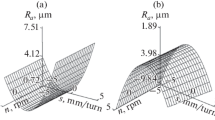Abstract
The influence of the chemical composition and different types of heat treatment on the structure formation and the hardness of a VST2K titanium alloy is studied. The dependence of the heat and pressure cutting parameters on the chemical composition, the structure, and the hardness of the VST2K alloy is found. The minimum cutting force and the temperature of samples with a hardness of 35–36 HRC in the cutting zone are determined. It is found that the dependence of the temperature–force parameters of the structural state of the alloy increases with molybdenum equivalent [Mo]eq. The correlation between the geometric parameters of chips with the machinability is studied. It is shown that the distance between the shear bands having formed in a chip structure can be used to estimate the machinability of the alloy only within one composition and that additional hydrogen alloying of the VST2K alloy degrades the machinability.
Similar content being viewed by others
References
Ya. L. Gurevich, M. V. Gorokhov, V. I. Zakharov, et al., Cutting Regimes of Hard-Processing Materials: A Handbook (Mashinostroenie, Moscow, 1976).
P. G. Petrukha, P. D. Bespakhotnyi, B. E. Brushtein, et al., Cutting of Hard-Processing Materials (Mashinostroenie, Moscow, 1972).
M. A. Davies, T. J. Burns, and C. J. Evans, “On chip morphology, tool wear and cutting mechanics in finish hard turning,” CIRP Annals–Manufactur. Technol. 45, 77–82 (1996).
I. V. Levin, I. Yu. Puzakov, N. Yu. Tarenkova, and V. V. Tetyukhin, “Secondary titanium alloy and method of its production,” RF Patent 2425164, Byull. Izobret., No. 21 (2011).
N. F. Anoshkin, G. A. Bochvar, and V. A. Livanov, Metallography of Titanium Alloys (Metallurgiya, Moscow, 1980).
V. F. Bobrov, Foundations of Metal Cutting Theory (Mashinostroenie, Moscow, 1975).
B. A. Kolachev, Yu. B. Egorova, A. A. Il’in, and L. V. Davydenko, “On the relation between the machinability of titanium alloys and their chemical and phase compositions,” Russian Metallurgy (Metally), No. 3, 284–289 (2002).
B. A. Kolachev, A. A. Il’in, and V. K. Nosov, “Possibilities and perspectives of hydrogen technology of titanium alloys,” Izv. Vyssh. Uchebn. Zaved., Tsvetn. Metall., No. 4, 57–64 (2001).
A. A. Il’in, B. A. Kolachev, V. K. Nosov, and A. M. Mamonov, Hydrogen Technology of Titanium Alloys (MISiS, Moscow, 2002).
Author information
Authors and Affiliations
Corresponding author
Additional information
Original Russian Text © S.V. Skvortsova, M.A. German, G.V. Gurtovaya, N.G. Mitropol’skaya, 2016, published in Metally, 2016, No. 4, pp. 79–86.
Rights and permissions
About this article
Cite this article
Skvortsova, S.V., German, M.A., Gurtovaya, G.V. et al. Effect of the structure of a VST2K titanium alloy on its machinability. Russ. Metall. 2016, 649–656 (2016). https://doi.org/10.1134/S0036029516070168
Received:
Published:
Issue Date:
DOI: https://doi.org/10.1134/S0036029516070168




